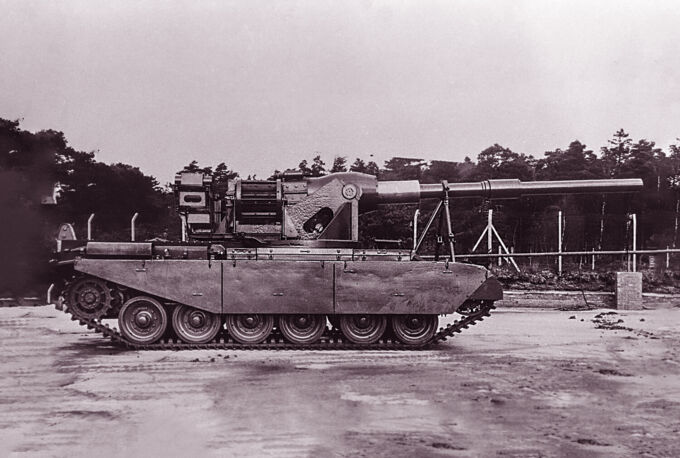During the Berlin Victory Parade, the IS-3 was first observed by the western allies. Among the British, fear grew about its armour and the fact that only the 17-pounder, firing the scarce APDS (Armour Piercing Discarding Sabot) stood a chance at penetrating it. As a result, a British program began to develop a gun capable of accomplishing the feat of penetrating the IS-3 frontally. When doubts arose about the planned vehicle, FV215, coming into service before cold war hostilities in sufficient numbers, a stopgap order was issued in 1950. This utilised the Centurion MK3 hull and mounted a 183mm anti-tank gun. This was named the FV4005.
The gun development program established the criteria as:
- Capable of penetrating 152mm of armour sloped at 60° at 1828 metres (2000 yards).
- The round was meant to be large enough to disable a vehicle should it not destroy it, regardless of where the hit on the vehicle.
It was decided the calibre would be 183mm and it would fire a HESH (High-Explosive Squash Head) round. The gun was called the L4A1. The warhead and propellant together weighed a whopping 96.5KG and was 76cm (29 ¾”). The muzzle velocity was 762m/s (2500 FPS).
The British company Vickers was contracted to produce the turrets. There were 2 turret “designs”. The first was the Stage 1 turret, which was really just a base for the gun to sit on. It had 360° traverse, albeit with a limited firing arc due to the immense 87 tonnes of recoil force. The Stage 1 turret had an assisted loader which lined up warheads and propellants to be rammed into the breech by the crew. The gun had -5° and +10° of gun depression and elevation. Both the Stage 1 and 2 turrets also sported a gun crutch that held the gun at 2° during travel. Both Stage 1 and 2 variants also had a shovel fitted to the rear of the vehicle, visually similar to a dozer blade, to help cope with the recoil.
Stage 2 turrets sported a 14mm thick enclosed fighting compartment. The assisted loading mechanism was expelled and a second loader was implemented. This made one loader responsible for either warhead or propellant. The turret could store up to twelve rounds, and a rail was implemented to help with replenishing the ammo racks from a truck over the engine deck.
Tests began in 1955 for Stage 2. While 150 rounds were fired with satisfactory results (there is footage of the turret of a Centurion MK1 being completely annihilated), problems from the recoil were discovered. One of these was the loosening of bolts and screws, proving dangerous for the crew inside as the small bits of metal became almost like shrapnel.
In August 1957, the project was cancelled along with FV215. Even though the gun had more than enough power, several reasons contributed to the projects cancellation, including:
- Heavy Shells could be made inaccurate by strong wind, making the accuracy at the maximum effective range of 2000 metres horrendous.
- The slow fire rate of 2 shells a minute was simply too low.
- Missiles were proving themselves as a better way to conduct long range anti-tank operations.
And so the service history of the FV4005, came to an end. However, in War Thunder, the FV4005 lives on. It is a hilarious vehicle to play with or against, whether you spot its box-like appearance or manage to score a ridiculous knockout. The gun functions as expected: a heavy hitter capable of eliminating the strongest foes. However, be warned, as a gun as large as that of the FV4005 comes with a mighty reload. The mobility is impressive for a tank as large as itself, based on the less-than-impressive mobility of the Centurion. The turret armour is lackluster however, being vulnerable to even .50 calibre munitions in some places. A solid tank destroyer, and a fantastic piece of history: The FV4005.
Thanks for reading! :)
Information courtesy of The Tank Museum
- https://www.flickr.com/photos/ajw1970/45277408421 (top photo)
- https://tankmuseum.org/article/the-FV4005 (information and second and third photos)



